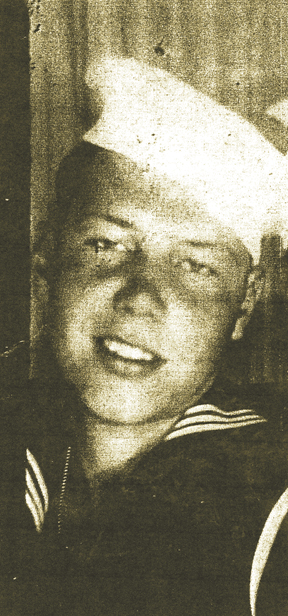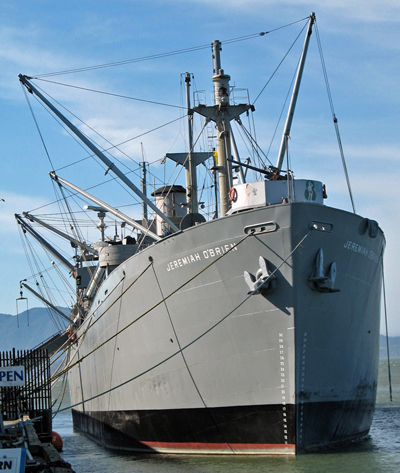- La Feria Community Holds Succesful Business Mixer Event
- Little Nashville to Take Place in Downtown Mercedes
- Lions Basketball Captures District Gold
- La Feria ISD Students Compete in Regional Chess Tournament
- Lions End First Half of 32-4A on a High Note
- La Feria ISD Held Another Successful Parent Conference
- Strong Appearance for Lions at Hidalgo Power Meet
- LFECHS Students Get to Meet Local Actress
- Students Participate in Marine Biology Camp
- Two LFECHS Students Qualify for All-State Band
A Sailor’s Story
- Updated: August 23, 2013

Seaman First Class John Cleburne Humphrey at age 18 in 1944.
A Los Fresnos Farm Boy’s Incredible Adventure
In the early years of World War II German submarines, planes and armed raiders roamed the seas and were sending allied supply ships to the bottom faster than they could be built. Enemy U-boats prowled the North Atlantic and the Gulf of Mexico, picking off American merchantmen at will. Japanese submarines and aircraft were likewise devastating American merchant ships in the South Pacific.
The response was the reactivation of the U.S. Navy Armed Guard. These out-manned and out-gunned volunteer sailors were tasked with a near-impossible mission: to protect U.S. shipping from the U-boat menace. The need for protection of supply lines was desperate.
That is where our story picks up with Los Fresnos native, Cleburne (John) Humphrey. Humphrey was born and raised on a farm in Arkansas in 1926, and grew up on another farm his father later bought in Los Fresnos, Texas. He thought his destiny was to be a farmer he related. He loved farming. However, the outbreak of a merciless, two-ocean war changed all that. He joined the U.S. Navy at 17 years of age in 1944—not to return to Los Fresnos until 1946.
“I guess I was really a young and adventurous young man and followed the example of my friends and joined the U.S. Navy.” he said. “After boot camp in San Diego, I volunteered for this new branch of service called the U.S.N. Armed Guard; it sounded exciting—believe me, it was,” he added. “After the war, I learned that the Navy gun crews had one of the highest casualty rates of any branch of the service.”

Seaman Humphrey with a few of his service medals. Photo: Bill Keltner/LFN
The training was fast and furious. Before we were assigned a ship, we attended gunnery school at the San Diego Naval Station. We learned all about 3-inch, 5-inch, 20mm and 50 caliber guns. Then we were ready for sea duty.” The graduate gunners were promoted to Seaman 1st Class and boarded a train for San Francisco to meet their ship and ship’s company.
“The Liberty Ship S.S. Brander Matthews was loading supplies as we boarded in September 1944, and she was to be our home for quite a while. Liberty ships were slow cargo ships of about 8-10,000 tons and had a top speed of 11 knots–making them perfect targets. The Navy gun crew had quarters separate from the Merchant Marine sailors, but ate with them. “The crew took good care of us. That was a lot different than enlisted sailors on the fleet ships.”
“Let me tell you about my 9-months on this Liberty, my first ship,” he said enthusiastically. “We joined a convoy at Long Beach, California with supplies destined eventually for a submarine base in Perth, Australia. Our first stop was Pearl Harbor where we joined another convoy headed for Einewetoc and Saipan in the Marianas Islands. The fighting was still going on. The Japanese were constantly bombing the convoys and Liberty ships that brought the supplies. We were in a number of air raids when we approached Saipan and while we were there. The Japanese still held Iwo Jima and Okinawa, and their planes would come from those two islands. “We were under constant aerial attack—we got very little rest.”
“One day a number of enemy planes were downed. Gunners on land and ships alike were blazing away. The sky was full of exploding shells and screaming, flaming Japanese airplanes crashing into the sea,” he said quietly as he relived the events of the war. “All our guns were firing, and we’re certain our gun crew downed a couple–but we never got any official credit.”
“And,” he continued, “there is so much to tell about the rest of the trip after that action.” After they finally delivered the materials at the submarine base in Perth, Australia, they joined another convoy destined for Calcutta, India with construction materials for the famous Burma Road. The ship next put in at Columbo, Ceylon (Now Sri Lanka). They loaded now for Arabia and Portugal, thankful to be finally out of the war zone.

Liberty Ship showing gun placement. Photo: Wikipedia.com
However, Mother Nature was not through with the S.S. Brander Matthews. A horrendous monsoon storm (what we call a hurricane) gripped the vessel for days off the coast of Madagascar. Liberty class ships were famous for dangerously rolling, pitching and yawing in storms. “We thought we were going to capsize or break apart at any moment,” he said. “It was so dangerous, we had to string life-lines because we were shipping water on both sides of the vessel—seas were washing over the decks.”
Seaman Humphrey was on his second ship in 1945, the S.S. Sea Perch, a 10,000 ton converted troop ship, when the war ended. They had gone to the Philippine Islands to bring back 2000 veteran Sea Bees (CBs) when they heard on the radio that the Japanese Imperial Army had surrendered. “Know what we did next?” he asked—“We dumped all the ammunition overboard and celebrated with the crew.”
“When we arrived at San Diego Naval Station, they assigned me to an LSM and that is where I was honorably discharged from the U.S. Navy after having a tour of duty that took me around the world, The government promptly disbanded the U.S.N. Armed Guard just as promptly as they formed it when they needed us,” he said.
So, now it was back to the farm in Los Fresnos. The sailor now home from the sea met an attractive San Benito girl named Virginia Gamble in Macombs Café one day in Los Fresnos.
“I couldn’t keep my eyes off of her,” he confessed. After dating for a year they were married on May 9, 1949 at the First Baptist Church in San Benito. The couple lived on the family farm with their two boys and daughter until he retired.
A final note: Seaman Humphrey said he would like to hear from anyone who served in the U.S.N. Armed Guard during the war. His number is 425-3353.

John and Virginia enjoying life in their Harlingen home.


